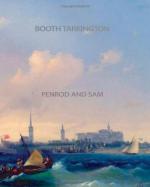|
This section contains 222 words (approx. 1 page at 300 words per page) |

|
Tarkington admitted that Mark Twain's Tom Sawyer and Huck Finn influenced his creation of Penrod. His Penrod was in one way more realistic, he insisted, because "Tom and Huck are realistic only in character. [Twain] gave 'em what boys don't get, when it comes to "plot."' Inevitably Penrod is compared to Twain's boys, or to Stephen Crane's juvenile heroes in his Whilomville Stories (1900). While Crane wrote of tough street kids from New York's Bowery, Tarkington found the boys of a middle-class neighborhood wild enough for his purpose.
Such nineteenth-century boys' books as Thomas Hughes's Tom Brown's Schooldays (1857), and Thomas Bailey Aldrich's The Story of a Bad Boy (1870) were familiar to Tarkington too, but he regarded their heroes as too moral to be real boys. His purpose was not to instruct young readers in how to be good boys, but to show actual boys in believable...
|
This section contains 222 words (approx. 1 page at 300 words per page) |

|




